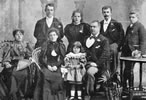Media
New Zealand’s mass media are concentrated in Auckland. It is the headquarters for the main networks for commercial radio and television – Television New Zealand, TV3 and Sky. Many film and television production houses are located in the region. It is also the centre of magazine and book publishing in New Zealand
Rocking the boat
In 1966 Radio Hauraki declared it would challenge the state’s commercial radio monopoly by transmitting from a ‘pirate’ boat off Great Barrier Island. As the vessel left port, police boarded the boat, disabling its engine and arresting the crew. The pirates soon tried again, and succeeded. In 1970 the government bowed to public pressure and legalised private radio stations. Radio Hauraki returned to shore.
Print media
Auckland newspapers had a chequered history until the Southern Cross amalgamated with the New Zealand Herald in 1876. Under the latter title it became a successful conservative paper and continues in that mould today. The Auckland Star, founded in 1870, provided a different voice as Auckland’s other major paper until it closed in 1991. Diverse interests of Aucklanders have found expression in Metro magazine – which often glamorises the city’s life – and myriad community and ethnic newspapers.
Film
The Hayward brothers were pioneer film-makers in the early 20th century. Today several film festivals highlight the enormous diversity of films, notably the International Film Festival, held annually since 1969. Films such as The piano feature West Coast beaches as a backdrop, while the popular television soap opera Shortland Street is set on the North Shore. Sione’s wedding, the first New Zealand/Samoan feature film, was shot in Grey Lynn.
Fashion
Auckland is the centre of New Zealand’s fashion industry. Its leading designers include Elizabeth and Neville Findlay, who started the influential label Zambesi in 1979. They were among the first to express a strong local identity in their designs. Other fashion houses include Workshop, Karen Walker, and Trelise Cooper. Since 2001 Auckland has hosted the Air New Zealand Fashion Week, the country’s premier fashion event.
The music scene
Auckland is a vital hub for popular music. In the 2010s it was home to most of New Zealand’s music and record companies, music magazines, and television and radio stations, luring artists seeking to advance their careers. Since 2000 the Music Industry Commission has assisted radio stations like BFM and Mai FM to promote new musicians. The Big Day Out was Auckland’s biggest music festival, drawing crowds of 30,000 each summer until declining attendance forced its cancellation in 2015. Pubs and clubs cater for different musical tastes. Until its closure in 2018 Newton’s Kings Arms was the best rock venue, while Karangahape Road (K’ Rd) clubs were the heart of Auckland’s dance culture.
Hip hop
The region’s music scene is distinctive for its strong hip-hop culture, first channelled through American Samoa in the 1980s and revitalised by second- and third-generation Pacific Islanders in central and South Auckland. The movement has embraced graffiti, rap, clothing, and community programmes. Hip-hop artists such as Che Fu and Nesian Mystik and the recording label Dawn Raid have influenced mainstream popular music.
Religious life
The region has diverse religious roots. In the 19th century Catholic Bishop Pompallier, Anglicans Robert Maunsell and Bishop Selwyn, and the Wesleyans pioneered mission work. The vitality of Baptist, Congregationalist, Jewish and Unitarian groups made Auckland more similar to US cities than to the rest of New Zealand.
A number of churches, including Anglican, Methodist and Baptist, have theological training colleges in Auckland. The University of Auckland has a chair of theology.
Since the Pacific Islanders’ Congregational Church in Newton became the city’s ‘Pacific village’ in the 1960s, churches have been a focal point of Pacific people’s community life. In 2013 the largest Christian denomination was Catholic, their numbers boosted by Asian Catholics seeking a Catholic education. Adherents of other religions make up a significant but small percentage of the population.

